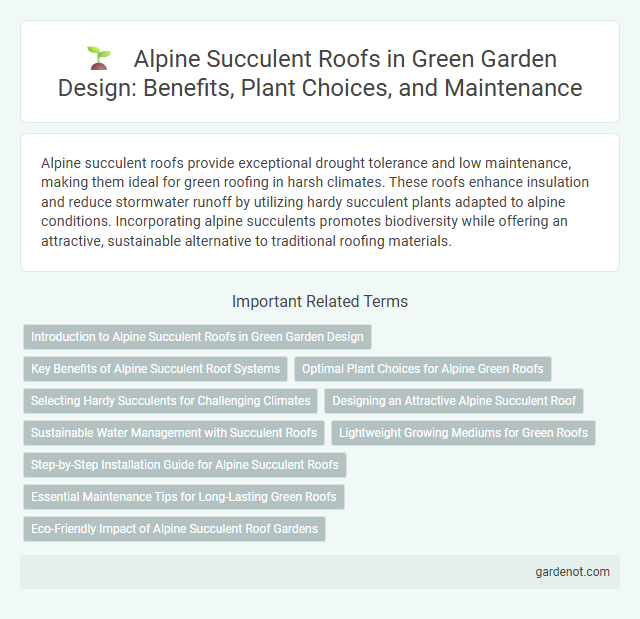Alpine succulent roofs provide exceptional drought tolerance and low maintenance, making them ideal for green roofing in harsh climates. These roofs enhance insulation and reduce stormwater runoff by utilizing hardy succulent plants adapted to alpine conditions. Incorporating alpine succulents promotes biodiversity while offering an attractive, sustainable alternative to traditional roofing materials.
Introduction to Alpine Succulent Roofs in Green Garden Design
Alpine succulent roofs incorporate hardy, drought-resistant plants that thrive in high-altitude environments, making them ideal for sustainable green garden design. These roofs provide excellent insulation, reduce urban heat island effects, and require minimal maintenance due to the succulents' water-storing capabilities. Integrating alpine succulents into green roofs enhances biodiversity while promoting eco-friendly urban landscaping solutions.
Key Benefits of Alpine Succulent Roof Systems
Alpine succulent roof systems provide excellent drought resistance due to their ability to store water in thick, fleshy leaves, significantly reducing irrigation needs and promoting water conservation. Their hardy nature and adaptability to extreme weather conditions enhance roof durability and reduce maintenance costs over time. These green roofs improve urban air quality and thermal regulation, contributing to energy savings and a healthier environment.
Optimal Plant Choices for Alpine Green Roofs
Alpine succulent roofs thrive with drought-tolerant species like Sedum and Sempervivum, which offer resilience in harsh, high-altitude conditions. These plants require minimal maintenance and efficiently retain water, making them ideal for sustainable green roofing systems in alpine environments. Their shallow root systems also prevent roof damage while enhancing thermal insulation and biodiversity.
Selecting Hardy Succulents for Challenging Climates
Alpine succulent roofs require selecting hardy succulent species that can withstand extreme temperature fluctuations, intense sunlight, and limited water availability. Sedum album, Sempervivum tectorum, and Delosperma cooperi are ideal choices due to their drought tolerance and resilience in cold alpine environments. These succulents create a durable, low-maintenance green roof that enhances insulation and supports biodiversity in challenging climates.
Designing an Attractive Alpine Succulent Roof
Designing an attractive alpine succulent roof requires selecting hardy, drought-resistant plants such as Sempervivum, Sedum, and Jovibarba that thrive in shallow, well-drained substrates. Incorporate varied textures, colors, and heights to create visual interest while ensuring proper layering for optimal water retention and root aeration. Integrate stone or gravel accents to enhance natural alpine aesthetics and improve roof drainage for long-lasting plant health.
Sustainable Water Management with Succulent Roofs
Alpine succulent roofs provide sustainable water management by utilizing drought-tolerant succulent plants that efficiently retain and absorb rainwater, reducing runoff and erosion. These succulent species, adapted to harsh alpine conditions, create a natural water buffer that minimizes irrigation needs and supports urban cooling. Integrating alpine succulents on green roofs enhances stormwater retention, promotes biodiversity, and contributes to resilient, eco-friendly building practices.
Lightweight Growing Mediums for Green Roofs
Alpine succulent roofs utilize lightweight growing mediums specifically designed to support water retention and aeration while minimizing load on structures. These mediums often combine expanded clay, perlite, and pumice to create an optimal environment for drought-tolerant alpine succulents. Lightweight substrates not only improve drainage but also enhance root stability, essential for the survival of succulents in harsh rooftop conditions.
Step-by-Step Installation Guide for Alpine Succulent Roofs
Carefully prepare the roof substrate with a strong waterproof membrane followed by a root barrier to protect underlying structures. Install a specialized drainage layer to prevent waterlogging, then add a nutrient-rich, well-draining soil mix designed for alpine succulent species. Plant a variety of drought-tolerant alpine succulents by spacing them to allow for growth, then maintain the roof with minimal watering and regular inspections to ensure healthy establishment and longevity.
Essential Maintenance Tips for Long-Lasting Green Roofs
Alpine succulent roofs thrive with minimal yet crucial maintenance, including regular inspection for drainage issues and removal of invasive weeds to ensure longevity. Proper watering techniques during dry periods and periodic trimming promote healthy growth and prevent plant overcrowding. Monitoring soil depth and replenishing nutrients as needed sustains the resilience and vibrant appearance of these drought-tolerant green roofs.
Eco-Friendly Impact of Alpine Succulent Roof Gardens
Alpine succulent roof gardens provide significant eco-friendly benefits by enhancing urban biodiversity and reducing the urban heat island effect through their natural heat absorption and retention properties. These drought-resistant plants minimize water usage, promoting sustainable landscaping practices that conserve precious resources. Their ability to improve air quality by filtering pollutants and capturing carbon dioxide further contributes to a healthier environment and reduced carbon footprint in urban areas.
Alpine succulent roof Infographic

 gardenot.com
gardenot.com